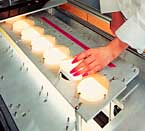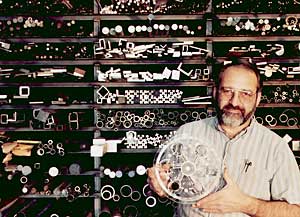


Unique healthcare and research tools are made to order, right around the corner
Medicine Shop

Pancreas digestion chamber

“At a medical center, there's an intense need for someone who can create gadgets. Kreitler is a superb manager, and he's assembled a group of 'old-world' craftsmen who take pride in what they do.”
Harold Burton, PhD


Plaque picker
![]()
In a small building on Scott Avenue, the air smells of oil and machinery. The equipment and floor are very clean, except for a pile of bright steel shavings at the foot of a lathe. Manuals and tools crowd workbench shelves, and banks of small compartments reach to head-height. On the wall hangs a calendar featuring glossy color photos—not of girls in swimsuits, but of heavy construction equipment.
The machine shop at the School of Medicine is not your average university department. Its existence, however, is critical to the medical professionals it serves. Financially independent, the machine shop works on a contract basis with individual researchers to produce devices as small as an assistive pump for implantation in a premature baby's heart, and as large as an arm for hoisting an electric motor.
“At a medical center, there's an intense need for someone who can create gadgets,” says Harold Burton, PhD, professor of anatomy and neurobiology. At Washington University, that need is filled by manager John Kreitler and the staff of the machine shop, who fabricate novel equipment for researchers and physicians. The machine shop's inventions help neurobiologists study the brain and geneticists sequence the genome. They aid pediatricians in correcting birth defects and radiologists in treating tumors. In addition, the machine shop provides railings, grates and other fixtures that make the medical campus safer.
“The machines they make work,” says Burton.
Kreitler, a burly, bearded man, wears workboots and carries a sheathed pocket knife on his belt. His large hands bear the nicks that come from working with machinery. He gained his early experience working on automobiles, trucks and airplanes, and he earned a degree from Ranken Technical College. He joined Washington University in 1980, and he and his staff of six have been located at the medical school since 1992, when a number of university machine shops merged into a central facility.
Each development process is unique. Some researchers bring
in a machine they have purchased and ask the shop to modify it. One such
device is a Cuisinart which Kreitler's team customized so that it can
be used in spraying coatings onto the time-release particles to be packed
into drug capsules. Other researchers bring in a plan or sketch of what
they need. “John and his guys are good to bounce ideas off,”
says Joseph T. Strong, research engineer at the Genome Sequencing Center.
“Often, they'll improve the design, changing it to make it easier
to fabricate.”

Manager John Kreitler stands in front of the machine shop's stock rack holding a piece of the M6 Heart Valve Durability Tester, a device the shop produced in collaboration with the Hilltop's School of Engineering and Applied Science. The M6 is used to fatigue-test artificial heart valves and other devices.
In other cases, the scientists have no idea what sort of machine they need, they can only describe what they want it to do. “We get them to tell us the whole process,” Kreitler explains, “even the seemingly unimportant details. Sometimes we go to the person's lab to see for ourselves.” Gaining this in-depth understanding of the task helps the machinists avoid costly design errors.
Elaine Mardis, PhD, assistant professor of genetics and director of technology development at the Genome Sequencing Center, for whom the machine shop has made or modified much equipment over the years, notes that the School of Medicine is lucky to have such a facility. “We'll be in a meeting at another center and we'll say, 'Oh, we can just have this made on campus,' and our colleagues' jaws will drop. They'll ask, 'You have guys who can do this?'”
Kreitler and his team thrive on the steady stream of new people bringing different kinds of challenges to the shop. “What we like most about the job,” he says, “is the variety.”
The pancreas digestion chamber
Researchers use this device to break down tissue so they can obtain islet cells. Islets, cellular masses in the pancreas, are the source of insulin. Pancreatic tisue is put into a chamber and agitated. Glass balls and enzymes break down the tissue, freeing the islet cells for collection.
“This is the method of choice for islet cell isolation today,” says Barbara Olack, research associate in general surgery. It is being used by the School of Medicine and the nine other centers involved in a worldwide study of the Edmonton Protocol for islet transplantation, a therapy the scientists hope will free many diabetics from the need to take insulin.
Braillereader
The braillereader aids scientists studying the human brain. Harold Burton's group images brain activity of sighted and blind volunteers as they read in order to learn more about the areas responsible for language, touch and visual information. The volunteers perform language tasks inside a magnetic resonance scanner. Sighted people look at visual displays projected onto a mirror. For the blind, Kreitler came up with the braillereader. It is a housing made of plastic, because metal introduced into the MR scanner produces shadows on the image. Inside is a cardboard fanfold that feeds words embossed in braille one at a time to the subject.
The studies will help Burton's group determine whether loss of sight leads to new functions in certain brain areas and expansion of areas used for touch, and may contribute to methods for evaluating and rehabilitating the visually impaired.
And now for a really great grate
A stainless steel grate in the sidewalk in front of the West Building was designed and installed by the machine shop to prevent fires. There is an electric substation in the basement, and warm air exhausts through the grating. In cold weather, people waiting for the bus like to stand on it. Too many of them, unfortunately, drop trash and cigarette butts. These items used to fall through the grating that was then in place. Small fires occasionally started. If one of them had reached the electric substation, it could have turned into a very big fire. The new grate catches the debris and eliminates that danger.
Plaque picker
A robot the machine shop built, the plaque picker, transfers samples of genetic material. Since it was developed in 1994, it has saved researchers at the Genome Sequencing Center countless hours of drudgery.
To prepare a strand of DNA for sequencing, scientists chop it up into manageable lengths. They then copy each length so that many people can work on it. The copying, or cloning, is done by inserting the DNA into bacterial cells. Many such samples are grown on a single petri dish. When they are ready for harvesting, the plaque picker takes a picture of the petri dish, and translates the data into coordinates showing where each sample is on the dish. Its robotic arm then speedily and accurately tranfers them to wells in a tray.
“People used to do this by hand, using toothpicks,” says Eric T. Stuebe, research engineer. “Having robots do the task has freed up technicians for work that is less tedious.”
Gel loader
The Genome Sequencing Center's gel loader is another device the machine shop developed to help researchers make the most efficient use of the high-speed (and high-cost) sequencers. Though rendered obsolete by newer technology, the gel loader was used to prepare samples of DNA, relieving technicians from performing a tedious and time-consuming task.
The DNA samples were sealed in a chamber and pressurized, which forced them into narrow tubes called capillaries. The capillaries fed them into slab gels. To prepare the slab gel, researchers squeezed gel into a narrow space between glass plates. The comb, another machine shop product, made channels in the gel. The DNA samples were loaded into these channels.
In sequencing, different color fluorescent dyes are tagged to each base — the smallest unit of genetic information. As an electric current drew the samples through the slab gel and a laser beam lit them up, a portion of genetic code appeared on the sequencer's screen in the form of a bright beaded curtain, creating what has become one of the most familiar images of the genome era.
Lens stretcher
This device helps V. Nathan Ravi, MD, PhD, assistant professor
of ophthalmology and visual sciences and of chemical engineering, explore
the question of why almost everyone needs bifocals after age 40. To study
the aging process in the eye, Ravi's lab needed a mechanical simulation
of the ciliary body, the part of the eye that alters the shape of the
lens so that a person can focus on near and far objects. A donor lens
and attached muscle tissue are fixed to the ends of eight stainless steel
arms with micromechanical sensors at the center of a double ring. When
the top ring is turned clockwise or counter-clockwise, the arms attached
to the lower ring move in or out. By simulating the natural movement of
the eye as it shifts focus, the device helps Ravi's group investigate
the biomechanics of focusing, and understand why this process grows less
efficient with age. The research may contribute to development of an artificial
lens implant which would eliminate the need for bifocals. ![]()